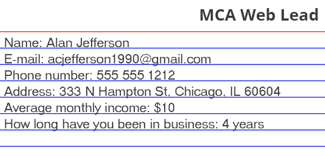Alright, you’ve scored some web leads! But have youscored those leads? Lead scoring is an incredibly important process in your lead distribution business. According to Direct Marketing News, 84% of companies with a CRM have a lead scoring process. But how do you assign a score to a lead? Well, read on, and let’s find a web lead to learn about that process.

So let’s come up with our own web lead here, for a man asking for Merchant Cash Advance quotes for his new business:

To start scoring, each category of the web lead gets assigned a point value. Is their name real? Add a point or two. Is it fake? Subtract some points! At the end, we tally up all the points, and ultimately get a final score. Depending on how picky you are and what parts you prioritize, an “acceptable” score will vary, but an acceptable score will end up as a positive number, generally. So let’s take a look at the explicit information first:
Demographic info
This is looking at the potential prospect and making sure the basics line up: name, contact number, e-mail, address, and age. Is their name something real sounding, or is it Mickey Mouse? Does their phone number look legitimate? Does their address exist? These give you the most immediate feedback on how useful this lead will be, and will generally be worth a good amount of points. But even robots can come up with decent sounding last names, or even steal information to submit fake leads. Because of this, correct information may garner, say, +2 points, but a fake phone number, stranding this potential contact with no way to get in touch, may be worth -5.
Demographic info can expand beyond just the basics for some verticals. Health insurance companies tend to value leads from smokers less than others, for example. Still, a smoker wouldn’t make or break a potential customer’s chances, so smoking may only subtract a point or two.

Company info
Leads in B2B verticals may offer information about their place of employment. Besides making sure that the business isn’t totally made up, some research is generally useful to make sure it fits your needs. For example, a company of 500 is likely to need bulk paper needs, but a company of 1-5 employees is less likely to need 10,000 reams of paper. Still, that can’t really be ruled out (my origami crane business is booming, I swear), so business scores tend to be worth relatively little. But of course, it can exist on a spectrum, since some businesses can be more useful than others to certain clients.
Specific information
This information directly relates toyour vertical. In the case of Merchant Cash Advance above, knowing an average monthly income and lifespan of the business is necessary to make accurate assessments of the viability of the prospect. This will generally be higher than company info but below demographic info, since it directly relates to the need the lead has for your company. If the information seems implausible, then the lead may take a hit.
This is the easy stuff to check. Let’s take a look at our lead from above again.
Name: Alan Jefferson (+2 - sounds realistic.)
E-mail: acjefferson1990@gmail.com (+3 - very reasonable e-mail address. Includes the name from above.)
Phone number: 555 555 1212 (-4 - Obviously fake phone number. Alan, how could you?)
Address: 333 N Hampton St, Chicago, IL 60604 (+2 - Zip code and city matchup. Address exists.)
Average monthly income: $10 (-2 - Unreasonable income.)
How long have you been in business: 4 years (+1 - This business has been around for a while, supposedly.)
Add it all up, and we have +8 and -6 for a total score of +2! Sounds like Alan Jefferson may be getting an e-mail soon. But there are other factors we can include that aren’t so obvious - the implicit information:
Online behavior
One thing that we can do with a web lead that was nearly impossible before the internet was to see how the lead interacts with the rest of our services. Like a customer wandering around a store, we can keep track of where a web lead has been on our site besides the contact page. If they’ve been checking out the pricing page before filling in their contact info, it’s safe to assume they thought the prices were reasonable, and the chances of making that sale go up dramatically. If they jumped on your landing page from google, filling out their info, then bailed immediately, they may not get many points, or could even lose them. Depending on the layout of your site, this scoring system may greatly impact the quality of the lead.
We check our analytics and see that “Alan Jefferson” filled out all of his information and hit submit in less than a second. This doesn’t seem quite as real anymore, and Alan gets -5 points for auto-filling contact information. At a score of -3, this lead is no longer useful to your sales team and may be filed away.

Obviously, doing this by hand would be incredibly tedious, and unnecessarily time consuming if you do it for every single web lead. Getting an automated lead scoring system like leadQC is just one solution to this problem. leadQC is built in to every boberdoo system. To see how this automated scoring system can improve your business, request a demo today by clicking the banner above or calling 800-776-5646!
